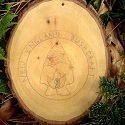I am also new to bushcraft, but have been hillwalking and camping on campsites for some years. I camped on the red squirrel campsite in glen cove last year. They allow campfires and I intend on returning there this year and using the setup in your link. I have already practiced carving the pot hanger. Most campsites seem to discourage open fires. My wife is happy to camp but not so sure about rough camping.
I will be ordering one of these pot hangers when they come back in stock...
http://www.thebushcraftstore.co.uk/t...er-17215-p.asp
Looking forward to putting into practice all the reading I have been doing recently.
Greg
]




 Reply With Quote
Reply With Quote
 ) of twisting a coat hanger and then bending it into a large hook for one end and a smaller hook at the other. The larger of the two hooks can be attached directly to a supporting log to suspend it, or you could bend it some more into a loop and then twist the end back on itself so you can just tie it to some cord
) of twisting a coat hanger and then bending it into a large hook for one end and a smaller hook at the other. The larger of the two hooks can be attached directly to a supporting log to suspend it, or you could bend it some more into a loop and then twist the end back on itself so you can just tie it to some cord  .
.





 It is always a pleasure to see what you can make !, instead of buying it ready made. R Proenneke.
It is always a pleasure to see what you can make !, instead of buying it ready made. R Proenneke.